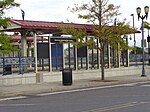Camden Waterfront
Neighborhoods in Camden, New JerseyRedeveloped ports and waterfronts in the United StatesTourist attractions in Camden, New Jersey

The Camden Waterfront, also known as the Central Waterfront, is a commercial and entertainment district in Camden, New Jersey, on the Delaware River south of the Ben Franklin Bridge and north of Port of Camden. The district is characterized by its visitor attractions and its location offering views of the river and the Philadelphia skyline. It is served by RiverLink Ferry which crosses the river to Philadelphia and the Cooper St-Rutgers, Aquarium, and Entertainment Center stations of the River Line light rail system. According to the 2000 U.S. census, the neighborhood has a population of 962.
Excerpt from the Wikipedia article Camden Waterfront (License: CC BY-SA 3.0, Authors, Images).Camden Waterfront
Locust Street, Camden
Geographical coordinates (GPS) Address Nearby Places Show on map
Geographical coordinates (GPS)
| Latitude | Longitude |
|---|---|
| N 39.935593 ° | E -75.126809 ° |
Address
Locust Street
08103 Camden
New Jersey, United States
Open on Google Maps









